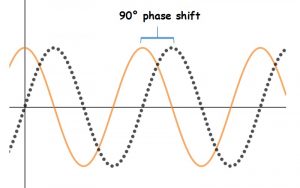Interference
34 Sine waves, phase and interference
Phase
Phase difference (also called phase or phase shift) describes how much one sine wave is shifted relative to another. Sine waves that are perfectly aligned peak to peak are called in phase. If one wave is shifted by half a wavelength (relative to the other), the troughs of one wave are aligned with peaks of the other and the waves are called perfectly (or completely) out of phase.

For waves that are neither perfectly aligned nor perfectly out of phase, phase is usually describe as an angle: zero degrees for perfectly in phase and 180 degrees out of phase for a shift of half a wavelength (aka perfectly out of phase). Notice that a phase shift of 360 degrees is the same thing as no phase shift at all- shifting a sine wave by a full wavelength gives the same wave back again.

Phase and interference
How two identical sine waves interfere depends on phase. If two sine waves are in phase, there is constructive interference. If two sines are perfectly out of phase, there is destructive interference. If the two waves are between neither in phase or perfectly out of phase , the waves interfere constructively at some locations and destructively in others. The result is a still a sine curve (with the same frequency as the two waves that are interfering). The amplitude is somewhere between the sum of the amplitudes of the two waves that created it and the difference. The animation Constructive and Destructive Interference on Dan Russell’s Superposition web page [1] shows how this works. (Ignore the math on Russell’s website, unless you find it helpful).
Image credits
All graphs created by Abbott using desmos.com
- Russsell, D. (2014, January 27). Superposition of waves. Retrieved from https://www.acs.psu.edu/drussell/Demos/superposition/superposition.html ↵
